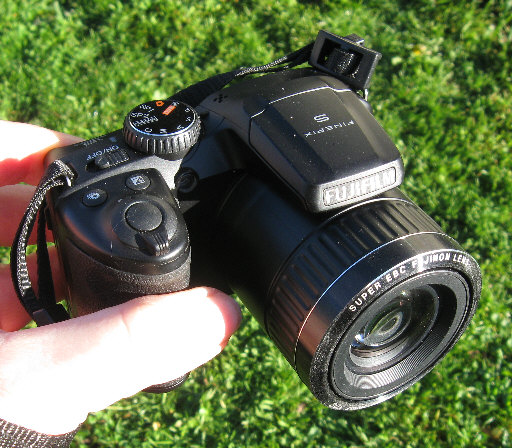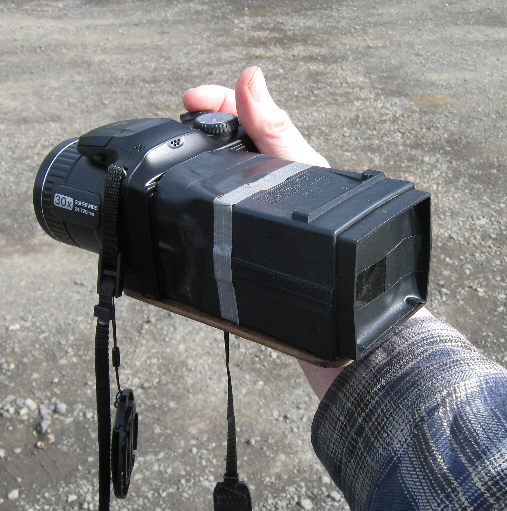 *
I have a soft spot for Fuji on account of their W3
stereo camera --and for keeping us in good film for so long.)
*
I have a soft spot for Fuji on account of their W3
stereo camera --and for keeping us in good film for so long.)
 *
I have a soft spot for Fuji on account of their W3
stereo camera --and for keeping us in good film for so long.)
*
I have a soft spot for Fuji on account of their W3
stereo camera --and for keeping us in good film for so long.)
* As far as I know, this camera (a Fuji S4800) has only one f/stop: wide open. The exposure effect of a smaller f/stop is achieved by inserting a neutral density filter. That's a good thing. Any reduction in aperture (ie: going to a higher f/stop number) would degrade the sharpness of the image. Here's why:
At best, yesterday's film cameras (nice ones that you'd buy in a camera shop) were understood to image 20 micron details (8/10,000 inch, or about 25 "line pairs" per millimeter), using practical films and depth-of-field tables. The design criteria for lenses and depth of field scales were often based on an assumed "least circle of confusion" measuring 1/1500th to 1/1700th the diagonal of the film format (same as the focal length of a "normal lens"). That's 43mm for a "35mm camera" that shoots "full" film frames --which works out to a 25 to 29 micron diameter circle of confusion.
* Were the camera lens and film perfect, and should the photographer want sub-micron resolution at the focal plane, there'd be very little depth of field to either side of the set focus.
* The pixel spacing for today's common, affordable hand cameras is often less than 2 microns (!) but the physical nature of light dictates that its typical f/3 (f/2.8 for grandpa's camera) lens tops out at 4 micron wide details. (A resolution test pattern's line pair bars tend to resolve significantly better). If you then "stop down" to (say) f/6 (f/5.6 in grandpa's denominations), you're supposed to get only get 8 microns details (due to the "diffraction limit" --the very physics of light) --which might be 4 times the sensor's pixel spacing and clearly at the end of the useful aperture range for low end, small sensor, digital hand cameras.
* But: you don't need those higher numbered f/stops for "depth of field" --at least, not until you start using serious amounts of zoom (and then you usually head toward a higher f/ratio anyway).
Depth of field is no problem for today's digital cameras when used at normal to wide angle focal lengths. That's because the focal length of the camera's lens is so short (say: the 5.8mm of my Canon A590 --compared to the 58mm normal lens of my old Minolta SRT-101 SLR 35mm film camera). For the SRT-101, 10 feet away is about 52 times the camera's focal length, but the A590 sees that distance as 520 times away --a rather "infinite" distance.
* Affordable digital cameras give us two miracles: 2 micron resolution sensors and zoom lenses which can image near that much detail.
In my tests of the S4800, I realized a "line pair" (alternating black and white bars) limit of 6 microns (3 microns per bar) at (a zoomed in) f/4.3, and 4 microns per bar at (a zoomed out) f/5.9 --which is simply terrific, plus there was surprisingly little light scatter/halation in the image. At the f/3.1 wide angle setting I could actually make out test target line pairs as close as 1.34 microns --the sensor's pixel spacing!

(*click* to enlarge)
* What we did with our Fuji S4800 was to build a detachable rear plastic viewing hood/box with an eye lens in the back --which resulted in the best electronic viewfinder I've ever used. (I suggest a minimum eye lens focal length of 4 inches.)
Lesson: At the very least, you want a camera with an automatic lens cap/closure. Ideally you want a camera with an internal lens zoom movement, and there've been a few on the market (like the original Sony Mavica).
* In the case of the S4800, I don't believe that attaching the lens cap captive to the camera strap was a factor, since the jamming occurred before the lens was able to extend. (Poor design!)
~ Half-depressing the shutter release, waiting 1/4 second to see your exposure information appear.
~ From that half-depressed state, shoot --enjoying almost no shutter delay.
~ Wait out the 1+ second/whatever black screen, after which, maybe more exposure information.
~ Wait until the unwanted, fursluginer exposure information goes away --
~ With the info off, the S4800 let me take a photo once every 7 seconds.
* Set the image sharpening option to normal/"no sharpening".
* See this page for more digital camera comments.
![]()